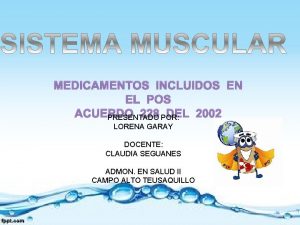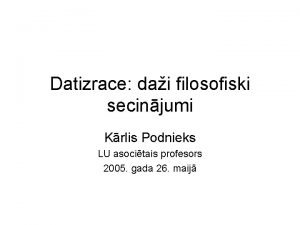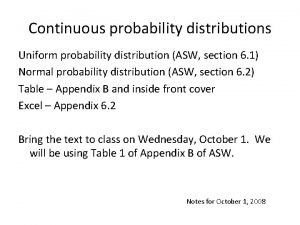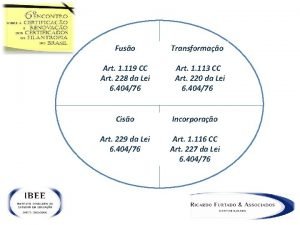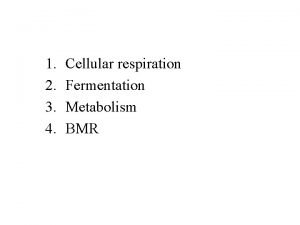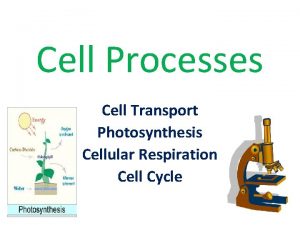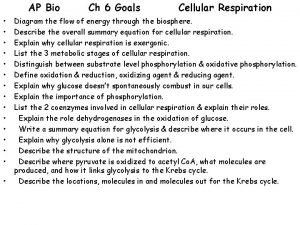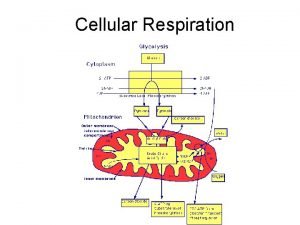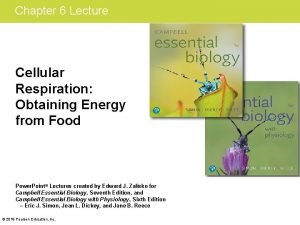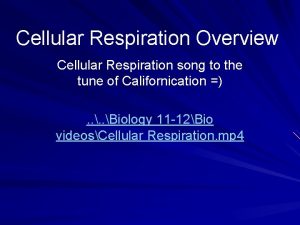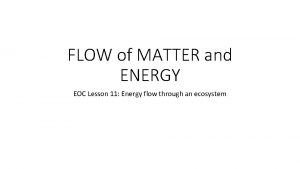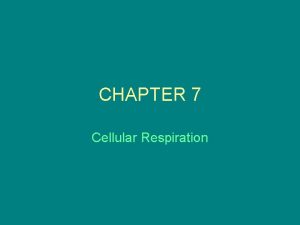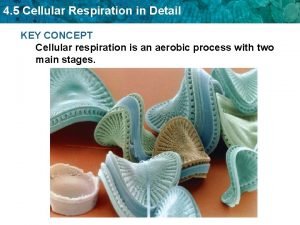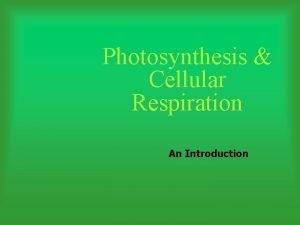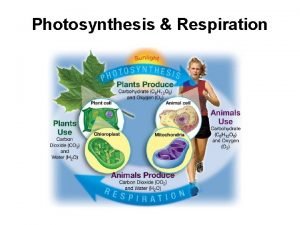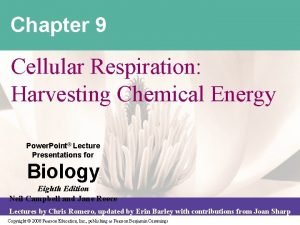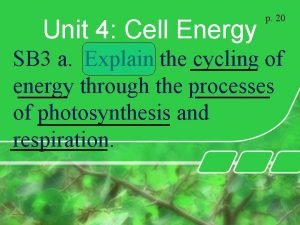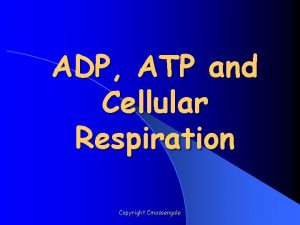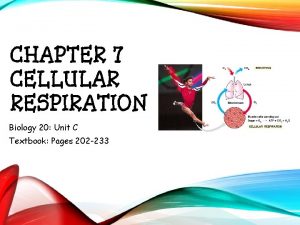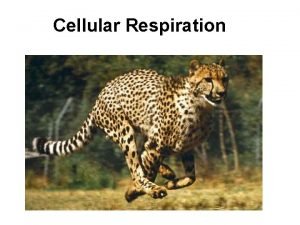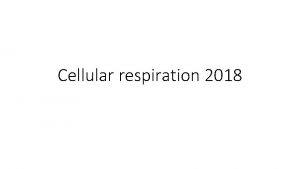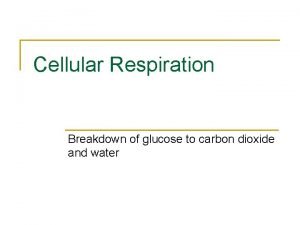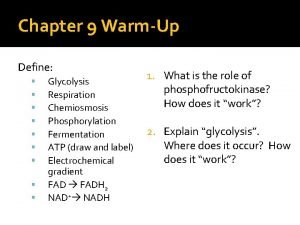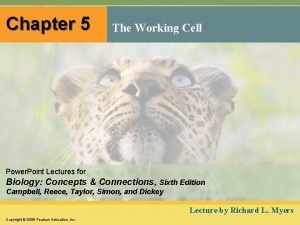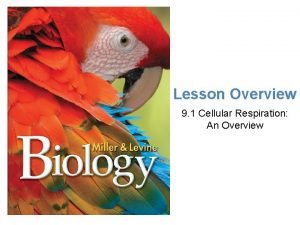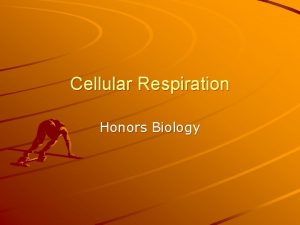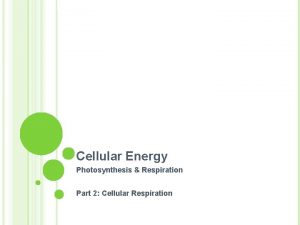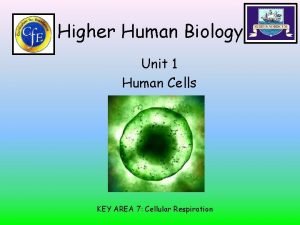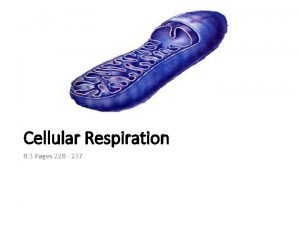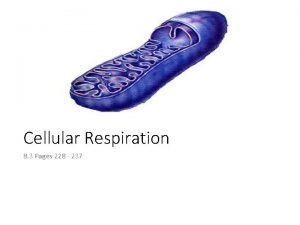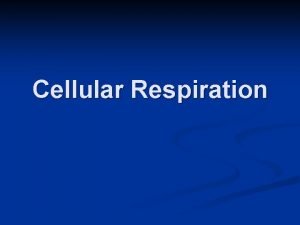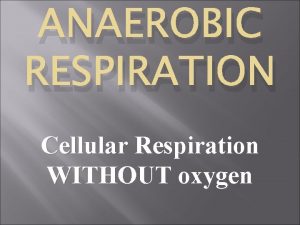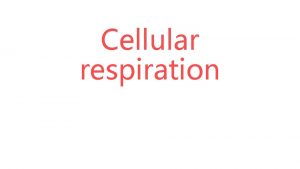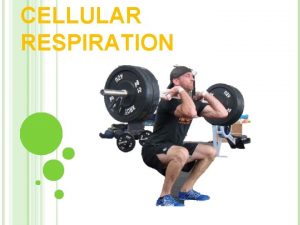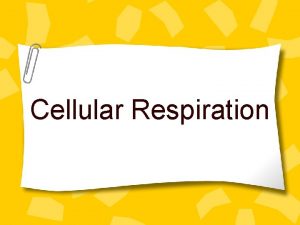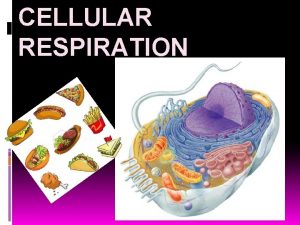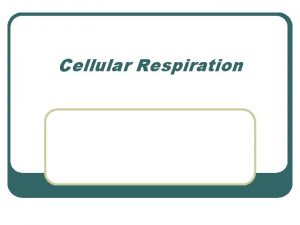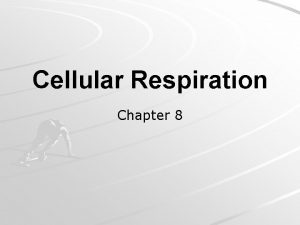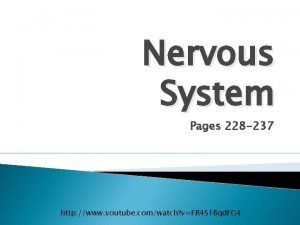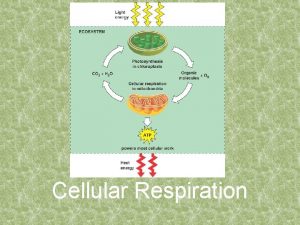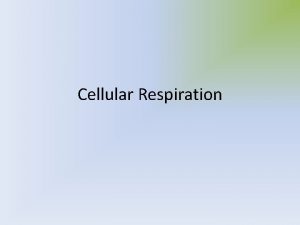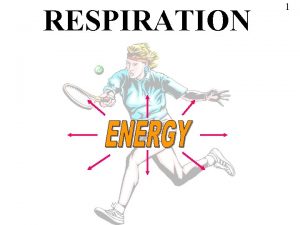Cellular Respiration 8 3 Pages 228 237 CELLULAR





































- Slides: 37

Cellular Respiration 8. 3 Pages 228 - 237

CELLULAR RESPIRATION 1. Converts (glucose) from food into ATP energy.

• • Overview of Respiration Happens in mitochondria All organisms respire! ATP energy is released used for cellular processes: active transport, photosynthesis, etc… Two Types: Aerobic (oxygen is present) Anaerobic (oxygen is not present)

Cellular respiration CELLULAR formula RESPIRATION C 6 H 12 O 6 + 6 O 2 6 CO 2 + 6 H 2 O + ATP Energy Glucose + oxygen carbon dioxide + water + ATP energy

STEPS of RESPIRATION 1. Glycolysis 2. Krebs cycle 3. Electron Transport Chain, or ETC

Step 1: GLYCOLYSIS • Glucose is Broken Down • Occurs in the CYTOPLASM: • ANAEROBIC! • Produces 2 ATP and 2 pyruvate

Step 2: KREB’S CYCLE (CITRIC ACID CYLE) • Occurs in the mitochondria: IT’S AEROBIC! • Pyruvate goes in • ATP and 6 CO 2 come out • Provides electrons (NADH and FADH) for ETC

Step 3: ELECTRON TRANSPORT CHAIN • Occurs in the mitochondria: it’s AEROBIC! • Produces 34 ATP using the electrons provided by Glycolysis AND the Krebs Cycle 36 ATP molecules total are produced during cellular respiration from one glucose molecule!

How photosynthesis & respiration relate. §Almost opposite processes §Photosynthesis produce food (store) §Respiration breaks down food (releases) §Photosynthesis uses CO 2 and releases O 2 §Respiration releases CO 2 and uses O 2

If there’s NO OXYGEN, respiration is ANAEROBIC, then… FERMENTATION!!! only 2 ATP are produced from Fermentation! The 2 pyruvic acid molecules from Glycolysis go through fermentation: Lactic acid fermentation: pyruvic acid -> lactic acid occurs in animals; ex. : muscle “pain” from too much exercise, yogurt Alcoholic fermentation: pyruvic acid -> ethyl alcohol occurs in yeast and some bacteria; ex. : alcoholic beverages, bread

Maybe an Amoeba Sisters Video Will Help • http: //www. youtube. com/watch? v=4 Eo 7 Jt. RA 7 lg&list=UUb 2 GCo. LSBX jm. I_Qj 1 vk-44 g

1. The formula CO 2 + H 2 O --- C 6 H 12 O 6 + O 2 is the formula for ? a. photosynthesis b. respiration 2. ___ is the process which breaks down food molecules to release energy and takes place in the mitochondria. a. photosynthesis b. digestion c. respiration 3. ___ is formed when ATP releases a phosphate. a. ADP b. AMP c. APP Quiz 4 4. Fermentation is a form of ___ respiration which occurs without the presence of oxygen. a. aerobic b. anaerobic c. antioxidant 5. The green pigment which is present in plant cells and allows them to go through photosynthesis is ___. a. chlorophyll b. chloroplast c. chlorosis

Cellular Respiration 2 36

Where does Glycolysis take place? Glycolysis

What does Glycolysis require?

What is step 2 of cellular respiration? Glycolysis

Where does the Krebs Cycle take place? Glycolysis

What does the Krebs Cycle Make?

What does the ETC Use?

What does the ETC Make?

Cellular Respiration – Part II Anaerobic Respiration Fermentation

ANAEROBIC - NO OXYGEN!! • Some cells can function for a little while without oxygen. • Other Cells may go their entire life without oxygen. But they still need ENERGY!!

ANAEROBIC CELLULAR RESPIRATION • Can release energy when oxygen is not present but. . . • It’s far less efficient. • Begins with glycolysis followed by fermentation.

Step 1: GLYCOLYSIS Same as Before: Glucose is Broken Down • Inputs: • Glucose • 2 ATP • Outputs: • 2 Pyruvate • 2 NADH • 4 ATP Occurs in the CYTOPLASM

Special Note: ü Glycolysis can produce thousands of ATP molecules in milliseconds. But quickly fills all available NAD+ (electron carriers) with electrons and the process stops, so it’s only good for short-term energy.

ANAEROBIC Step 2: FERMENTATION RESPIRATION 1. Type of anaerobic respiration that releases energy without oxygen 2. If oxygen is not present, the next step is either a. Lactic acid fermentation b. Alcoholic fermentation

ANAEROBIC Step 2: FERMENTATION RESPIRATION Lactic Acid Fermentation • Converts pyruvic acid into lactic acid and CO 2 • Responsible for food production using microbes (Swiss cheese) • Causes muscle fatigue/burning

ANAEROBIC Step 2: FERMENTATION RESPIRATION Alcoholic Fermentation • Converts pyruvic acid into alcohol and CO 2 • Responsible for food production using microbes (sourdough bread)

Summary Of Fermentation Glycolysis Fermentation 02+ C 6 H 12 O 6 6 CO 2 + 6 H 2 O + ATP + alcohol or lactic acid

Advantage of Aerobic Respiration Yields 66% more energy 36 - 38 net ATP That’s nearly 20 times more ATP than glycolysis alone.

Energy Yield without oxygen Fermentation 2 ATP (that’s 36 less ATP than aerobic respiration)

Chapter 8 Cellular Energy 8. 3 Formative Questions What is the overall purpose of cellular respiration? A. to make ATP B. to process H 2 O C. to store glucose D. to deliver oxygen

Chapter 8 Cellular Energy 8. 3 Formative Questions Which represents the general sequence of cellular respiration? A. TCA cycle chemiosmosis B. glycolysis Krebs cycle C. electron absorption phosphorylation D. aerobic pathway fermentation glycolysis electron transport catalysis anaerobic pathway

Chapter 8 Cellular Energy 8. 3 Formative Questions Which stage of cellular respiration is the anaerobic process? A. glycolysis B. Krebs cycle C. electron transport

Chapter 8 Cellular Energy 8. 3 Formative Questions Which molecule generated by the Krebs cycle is a waste product? A. Co. A B. CO 2 C. FADH 2 D. NADH

Chapter 8 Cellular Energy Standardized Test Practice What prevents pyruvate from entering the Krebs cycle and instead results in this pathway? A. a buildup of CO 2 B. a lack of oxygen C. an excess of glucose D. an increased demand for ATP

http: //www. bing. com/videos/search? q=crash%20 course%20 biology%20 cellular%20 respiration&FORM=VIRE 15&adlt=strict#view=detail&mid=B 5 DFEEAB 51 E 26 C 45 DC 4 4 B 5 DFEEAB 51 E 26 C 45 DC 44
 Printed pages vs web pages
Printed pages vs web pages External respiration vs internal respiration
External respiration vs internal respiration External respiration
External respiration Acuerdo 228 medicamentos pos
Acuerdo 228 medicamentos pos Romiešu jurists 170-228
Romiešu jurists 170-228 Cs 228
Cs 228 Hymn 228
Hymn 228 Asw 228
Asw 228 Art 228 cc
Art 228 cc Eaf 228
Eaf 228 Macromolecules in cellular respiration
Macromolecules in cellular respiration What is the equation for cellular respiration
What is the equation for cellular respiration Cellular respiration diagram ap bio
Cellular respiration diagram ap bio Cellular respiration process diagram
Cellular respiration process diagram Cellular respiration obtaining energy from food
Cellular respiration obtaining energy from food Cellular respiration song
Cellular respiration song Photosynthesis or cellular respiration
Photosynthesis or cellular respiration Redox reaction in cellular respiration
Redox reaction in cellular respiration Redox reaction in cellular respiration
Redox reaction in cellular respiration Concept 5 cellular respiration
Concept 5 cellular respiration The chemical process of photosynthesis
The chemical process of photosynthesis Biological significance of atp
Biological significance of atp Energy flow in cellular respiration
Energy flow in cellular respiration Concept map cellular respiration
Concept map cellular respiration Cellular respiration
Cellular respiration What is adp made of
What is adp made of Biology 20 unit 1 practice test
Biology 20 unit 1 practice test Cellular respiration chemical equation
Cellular respiration chemical equation Cellular respiration
Cellular respiration Three steps in aerobic cellular respiration
Three steps in aerobic cellular respiration Preparatory reaction inputs outputs
Preparatory reaction inputs outputs The stages of cellular respiration
The stages of cellular respiration Glucose cellular respiration
Glucose cellular respiration Gylcolysis
Gylcolysis Cellular respiration redox
Cellular respiration redox What is fermentation
What is fermentation Cellular respiration organelle
Cellular respiration organelle Higher human biology cellular respiration
Higher human biology cellular respiration



